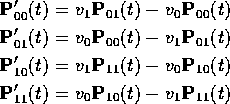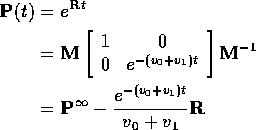Example: ![]() . Then
. Then
![]()
and the chain is otherwise specivied by ![]() and
and ![]() . The matrix
. The matrix ![]() is
is
![]()
The backward equations become

while the forward equations are

Add ![]() first plus
first plus ![]() third backward equations to get
third backward equations to get
![]()
so
![]()
Put t=0 to get ![]() . This gives
. This gives
![]()
Plug this back in to the first equation and get
![]()
Multiply by ![]() and get
and get
![]()
which can be integrated to get
![]()
Alternative calculation:
![]()
can be written as
![]()
where


and

Then

Now
![]()
so we get

where

Notice: rows of ![]() are a stationary initial distribution. If rows are
are a stationary initial distribution. If rows are
![]() then
then
![]()
so
![]()
Moreover
![]()
Fact: ![]() is long run fraction of time in
state 0.
is long run fraction of time in
state 0.
Fact:
![]()
Ergodic Theorem in continuous time.
Birth and Death Processes
Consider a population of X(t) individuals. Suppose
in next time interval (t,t+h) probability of population
increase of 1 (called a birth) is ![]() and
probability of decrease of 1 (death) is
and
probability of decrease of 1 (death) is ![]() .
.
Jargon: X is a birth and death process.
Special cases:
All ![]() ; called a pure birth process.
; called a pure birth process.
All ![]() (0 is absorbing): pure death process.
(0 is absorbing): pure death process.
![]() and
and ![]() is a linear
birth and death process.
is a linear
birth and death process.
![]() ,
, ![]() : Poisson Process.
: Poisson Process.
![]() and
and ![]() is a linear
birth and death process with immigration.
is a linear
birth and death process with immigration.
Queuing Theory
Ingredients of Queuing Problem:
1: Queue input process.
2: Number of servers
3: Queue discipline: first come first serve? last in first out? pre-emptive priorities?
4: Service time distribution.
Example:
Imagine customers arriving at a facility at times of a Poisson
Process N with rate ![]() . This is the input process,
denoted M (for Markov) in queuing literature.
. This is the input process,
denoted M (for Markov) in queuing literature.
Single server case:
Service distribution: exponential service times, rate ![]() .
.
Queue discipline: first come first serve.
X(t) = number of customers in line at time t.
X is a Markov process called M/M/1 queue:
![]()

Example: ![]() queue:
queue:
Customers arrive according to PP rate ![]() . Each
customer begins service immediately. X(t) is number
being served at time t. X is a birth and death process
with
. Each
customer begins service immediately. X(t) is number
being served at time t. X is a birth and death process
with
![]()
and

Stationary Initial Distributions
We have seen that a stationary initial distribution ![]() is
a probability vector solving
is
a probability vector solving
![]()
Rewrite this as
![]()
Interpretation: LHS is rate at which process leaves state j; process is
in state j a fraction ![]() of time and then makes transition at rate
of time and then makes transition at rate
![]() . RHS is total rate of arrival in state j. For each state
. RHS is total rate of arrival in state j. For each state
![]()
![]() is fraction of time spent in state i and
then
is fraction of time spent in state i and
then ![]() the instantaneous rate of transition from i to j.
the instantaneous rate of transition from i to j.
So equation says:
Rate of departure from j balances rate of arrival to j. This is called balance.
Application to birth and death processes:
Equation is
![]()
for ![]() and
and
![]()
Notice that this permits the recursion

which extends by induction to
![]()
Apply ![]() to get
to get
![]()
This gives the formula announced:

If
![]()
then we have defined a probability vector which solves
![]()
Since
![]()
we see that
![]()
so that ![]() is constant. Put t=0 to discover that
the constant is
is constant. Put t=0 to discover that
the constant is ![]() .
.